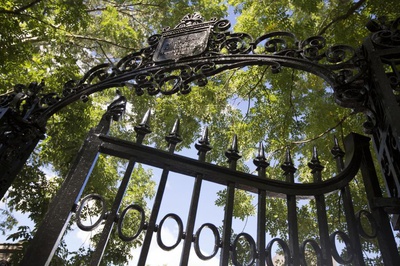
News
Harvard Researchers Develop AI-Driven Framework To Study Social Interactions, A Step Forward for Autism Research

News
Harvard Innovation Labs Announces 25 President’s Innovation Challenge Finalists

News
Graduate Student Council To Vote on Meeting Attendance Policy

News
Pop Hits and Politics: At Yardfest, Students Dance to Bedingfield and a Student Band Condemns Trump

News
Billionaire Investor Gerald Chan Under Scrutiny for Neglect of Historic Harvard Square Theater
‘Breakthough Prize’ Grants $3 Million to Univ. Researchers
A Harvard-affiliated scientist and a professor of Mathematics at Harvard received $3 million apiece as recipients of the Breakthrough Prizes in Fundamental Physics and Life Sciences.
Gary Ruvkun, a genetics professor at the Medical School and a researcher at Massachusetts General Hospital, and Jacob Lurie, who also won a MacArthur genius grant this year, received these honors from a panel of Silicon Valley executives, who founded the award in 2012.
The awards were given to 12 recipients in in the celebrity-studded “Breakthrough Prize Ceremony” on Nov. 9.
“They have good taste,” said Ruvkun of the panel, which includes Facebook co-founder and Harvard dropout Mark Zuckerberg. “They understand that math and science are really important and really important for what they do.”
Lurie gained recognition for his contributions to higher category theory, derived algebraic geometry, and several advanced facets of topology.
Ruvkun has been working both independently and in tandem with Victor Ambros, a biology professor at the University of Massachusetts Medical School in Worcester, to understand tiny pieces of genetic material that regulate gene expression in eukaryotes. Just 22 nucleotides long, these “microRNA” molecules regulate the production of proteins. While they serve an important function, they seemed at first to be “a little quirk of nature,” Ruvkun said of their initial identification of the first microRNA molecule in 1993.
The technology boom of the last two decades was responsible for Ruvkun’s “Breakthrough Prize,” in more than one way, he said. The rise of big data in the form of the Human Genome Project, which set out to unravel the entire genetic makeup of humans, facilitated the success of Ruvkun and Ambros’s findings in the scientific community. In 2000, the researchers discovered a second microRNA, at a time when 30 percent of the human genome had been decoded and the DNA sequence was being updated and shared constantly.
“At that point it just exploded,” Ruvkun said. “You don’t plan for those kinds of things, for thousands of people to be reading my work.”
With readily available information on the human genome from the Human Genome Project, Ruvkun and his lab determined that gene regulation at the small scale of microRNA molecules was widely applicable across many animals, including humans. The number of articles on microRNAs shot up from two in 1993 to nearly 35,000 today.
“It’s really just luck,” Ruvkun said. “There’s a lot of good science today that’s not that lucky.”
The 12 honorees ranged from astronomers to life scientists to mathematicians, spanning both theoretical and experimental projects. They celebrated the awards at a gala hosted by Seth MacFarlane in Mountain View, Calif.
—Staff writer Jessica A. Barzilay can be reached at jessica.barzilay@thecrimson.com. Follow her on Twitter@jessicabarzilay.
Want to keep up with breaking news? Subscribe to our email newsletter.
From Our Advertisers

Over 300+ courses at prestigious colleges and universities in the US and UK are at your disposal.

Where you should have gotten your protein since 1998.

Serve as a proctor for Harvard Summer School (HSS) students, either in the Secondary School Program (SSP), General Program (GP), or Pre-College Program.

With an increasingly competitive Law School admissions process, it's important to understand what makes an applicant stand out.

Welcome to your one-stop gifting destination for men and women—it's like your neighborhood holiday shop, but way cooler.

HUSL seeks to create and empower a community of students who are seeking pathways into the Sports Business Industry.
